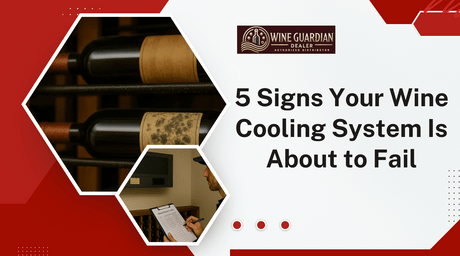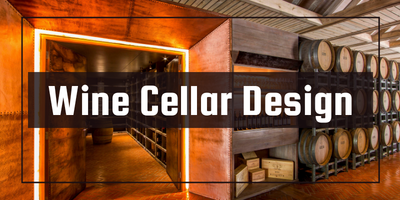
5 Signs Your Wine Cooling System Is About to Fail
Don’t wait for a costly surprise. Wine Guardian Dealer breaks down the top 5 signs your wine cooling system may be failing — and how to fix it before damage...
Jim Hopper
In Stock & Ready to Ship – Order Your Wine Cooling System Today!
Free Wine Cellar Expert Consultation | 📞 Call 1-800-260-1712
Start with a free expert consult—cooling system sizing, racking options, and no upsells.

Build your dream wine cellar—without costly mistakes or guesswork.
By Jim Hopper, Wine Cooling Expert
If you’re serious about wine, you’ve probably dreamed of having a wine cellar—and there’s no better place to build one than underground.
Why? Because underground wine cellars offer natural insulation, darkness, and a steady environment—everything your wine needs to age gracefully. But even though underground cellars have that “old-world charm,” they still need modern solutions to control temperature and humidity. A crucial element in this is a cellar cooling unit, which maintains the necessary temperature and humidity levels, ensuring optimal conditions for preserving your wine collection.
In this guide, we’ll walk through:
Before you start digging, make sure to check out our full Wine Cellar Design and Installation: Build a Beautiful, Functional Wine Room That Lasts for expert guidance on building underground spaces the right way.
Let’s dig in. 🍷
Going underground gives you a big head start on proper storage conditions.
These cellars tend to maintain a more stable environment than above-ground spaces. But without the right setup, you can still run into moisture issues, mold, or temperature spikes.

An underground wine cellar isn’t just a luxury—it’s smart engineering. Here's why going below ground is the preferred choice for wine connoisseurs and custom home builders alike:
Soil is an excellent insulator. Underground temperatures tend to remain relatively stable year-round, maintaining a consistent temperature, which is ideal for wine that requires a consistent 55°F (13°C). This natural buffer reduces the workload of your cooling system, making your cellar more energy-efficient.
Wine hates two things: light and movement. Being underground eliminates exposure to UV rays and minimizes vibrations from appliances or foot traffic—both of which can degrade the quality of your wine over time. Ultraviolet (UV) light can prematurely age wine, making underground storage ideal due to the absence of sunlight.
Why sacrifice living space when you can build down and effectively use all the space available? Underground cellars often utilize otherwise-unused square footage—beneath staircases, garages, or even outside your home with tunnel access. They can also be integrated into existing areas such as foundations or hillsides, making them a versatile option for various property layouts.
There’s something undeniably luxurious about a hidden spiral staircase leading to a dimly lit vault of vintage reds. Glass doors add to this elegance and convenience, making the experience of accessing your collection even more luxurious. A thoughtfully designed custom wine cellar can boost your home’s resale value while adding a unique architectural talking point. A custom Spiral Cellar provides unparalleled climate control for optimal wine preservation, ensuring your collection remains in pristine condition.

Designing an underground wine cellar is part engineering, part artistry. Here's what you need to get right:
Before breaking ground, assess the structural integrity of your foundation. Working with a contractor experienced in cellar construction ensures proper excavation and prevents future damage or leaks.
Warm air is your #1 enemy. A properly sealed cellar uses external waterproof membranes and internal vapor barriers (installed on the warm side of insulation) to keep the interior dry and mold-free. Sealing the concrete floors and walls creates a vapor barrier against air leaks and moisture, further protecting your wine collection. Concrete wine cellars are manufactured as one complete sealed unit without joins, enhancing their durability and resistance to leaks. Modular concrete wine cellars can be used for underground, above-ground, or embedded installations.
Use closed-cell spray foam or rigid foam board insulation to stabilize temperature and humidity. A minimum R-value of 19 is standard, though higher is recommended for extreme climates.
Modern wine cellar design is crucial, and choosing the right materials is essential. Use mold-resistant drywall or concrete, and opt for non-porous flooring like stone, tile, or sealed concrete. Avoid carpeting or untreated wood that absorbs moisture. Using food-safe oils like Pure Tung Oil can help maintain wood surfaces in a wine cellar.
LED lighting is essential—it emits no UV rays and minimal heat. Design your entrance carefully; spiral stairs, hatches, or even sliding doors can make for stunning and functional entry points.
Absolutely.
Underground cellars are cooler, but not perfect. You still need a dedicated wine cellar cooling system to maintain the proper temperature and manage:
📘 Related: Why Temperature Control Is Critical for Wine Storage

Once your cellar is built, it’s all about keeping your wine in pristine condition. Periodical inspections of the wine cellar should be scheduled to check for leaks, ensuring the environment remains optimal for wine storage.
Store bottles on their side to keep corks in contact with the wine, preventing oxidation. Consider the option of a round wine cellar, which offers a unique design and can accommodate a significant number of bottles. Horizontal storage of wine bottles is imperative for optimum conditions and proper aging, ensuring the longevity and quality of your collection. Custom wine racks allow flexibility for different bottle sizes, ensuring ideal storage for each wine type. Using high-quality materials for wine racking will ensure long-lasting reliable results in a wine cellar. Wine collections can benefit from being stored horizontally to keep the cork moist and prevent deterioration.
Sort your collection by varietal, vintage, or region. Use a cellar management system or simple spreadsheet to track optimal drink-by dates.
Even underground, light and movement can seep in. Use vibration-dampening racking systems and shield windows with UV-filtering materials if needed.
Building underground takes planning. Here’s what you’ll need to get right:
Even underground walls need to be insulated.
Use R-19+ for walls and R-30+ for ceilings.
Install on the warm side of insulation to prevent outside moisture from entering.
Underground rooms trap air. A dedicated system like the Sentinel Series Ducted Unit keeps air circulating evenly.
Go with low-heat LED lighting—not only does it look great, but it protects your wine from heat and UV damage.
Install waterproof membranes and a drainage plan in case of groundwater or leaks.
📘 Building in a basement? Check out: How to Build a Basement Wine Cellar

Yes, it’s underground—but that doesn’t mean it’s self-regulating. Precise climate control is essential to preserve wine integrity over time. In well-thought-out wine cellar designs, incorporating natural stone veneer can help maintain optimal conditions for wine preservation while also enhancing the overall aesthetic appeal of the cellar.
Natural insulation helps, but it can’t maintain the strict 55°F + 60% RH combo needed for proper aging. A dedicated wine cooling unit is non-negotiable.
Here are three top-rated options from the Best Sellers collection:
A powerful, quiet solution ideal for underground or hidden installations, the Wine Guardian Ducted Cooling System enhances wine cellar features by keeping temperature and humidity steady without noise inside the cellar.
Best for compact spaces or retrofits. Easy to install and highly efficient.
Perfect for dry climates—this keeps corks hydrated and prevents evaporation.
Many Wine Guardian systems offer Wi-Fi controls and mobile app access, so you can manage your cellar remotely and receive alerts if something’s off.
Avoid these pitfalls to save yourself thousands in repairs and spoiled bottles:
Without one, condensation can form and cause mold, rot, or warping.
A home AC unit can't maintain the narrow margins of temperature and humidity required. Always use a specialized system.
Entry doors must be insulated and sealed to avoid heat or humidity leakage.
Underground construction requires professional sealing. Cutting corners can lead to catastrophic flooding or mold growth.
Avoid incandescent or halogen bulbs that emit heat or UV rays. Stick to cool, UV-free LED lights.
Maintaining the pristine condition of your underground wine cellar is crucial for proper wine storage. Regular cleaning and inspection are key to ensuring your wine collection remains in optimal condition. Dust and dirt can accumulate on wine bottles and racks, potentially affecting the quality of your wines. To keep your cellar in top shape, aim to clean it every 6-12 months, depending on usage and environmental factors.
Use a soft-bristled brush or a microfiber cloth to gently remove dust and dirt from wine bottles and racks. Avoid harsh chemicals or abrasive materials that could damage your wine cellar or the bottles themselves. Regular cleaning not only keeps your cellar looking immaculate but also helps maintain the integrity of your wine collection.
In addition to cleaning, regular inspections are essential. Check the temperature and humidity levels to ensure they remain within the optimal range for wine storage. Inspect wine bottles for any signs of damage or deterioration, such as cracks, leaks, or mold. By staying vigilant, you can catch potential issues early and protect your valuable wine collection.
Proper maintenance of your wine cellar’s systems is vital for ensuring a stable environment for your wines. Regularly check the cooling system, humidity control, and ventilation to confirm they are functioning correctly. Filters should be inspected and replaced as needed to prevent dust and debris from accumulating and compromising the system’s efficiency.
For comprehensive upkeep, consider scheduling an annual professional inspection of your wine cellar system. A professional can identify potential issues before they escalate, ensuring your wine cellar operates at peak performance. This proactive approach helps maintain the ideal conditions for wine preservation, allowing your favorite wines to age gracefully.
By adhering to these maintenance and upkeep practices, you can ensure your underground wine cellar remains a sanctuary for your wine collection, providing the perfect environment for storing and aging your favorite wines.
“We converted a root cellar into a full wine room. We didn’t think we needed a cooling unit—until a hot summer nearly ruined our collection. The Wine Guardian system fixed everything and even alerts us if temps spike.”
– Diane & Steve, Homeowners in Michigan
“I design luxury homes, and underground cellars are a must for our clients. Wine Guardian is the only system I trust—it’s quiet, consistent, and supports full automation.”
– Carlos R., Custom Home Builder in Texas
Whether you're upgrading a basement, digging a new underground cellar, or converting an old root room, Wine Guardian has the solution to protect your wine the right way.
👉 Shop Wine Guardian Cooling Systems
Choose from ducted, split, and wall-mounted systems for any cellar style or size.
📞 Call 1 (800) 260-1712 for a FREE wine cellar climate consultation
We’ll help you plan, size, and choose the perfect system—so your wine stays safe for years to come.
Yes—but the cost varies. Excavation, waterproofing, and a high-quality cooling system add up. Expect to invest anywhere from $20,000 to $100,000+ depending on size and features. Installing an underground wine cellar can typically be completed in a few days.
Absolutely. Many homeowners retrofit basements with proper insulation, vapor barriers, and a Wine Guardian cooling unit to create ideal conditions, transforming their space into a wine store that showcases unique wine storage solutions.
Yes—especially for air circulation and mold prevention. Wine Guardian systems often include ventilation options or add-ons for this purpose. Air vents are necessary in underground wine cellars for air exchange, ensuring the environment remains balanced and suitable for long-term wine storage.
The gold standard is 55°F (13°C), with humidity around 60%.
Decades. When stored correctly, many reds and dessert wines can age 10–30+ years.
🛒Shop our most-loved Wine Guardian cooling systems today.
🛠️Protect your wine with the most trusted systems on the market.
❤️Tested, reviewed, and loved by serious collectors like you.